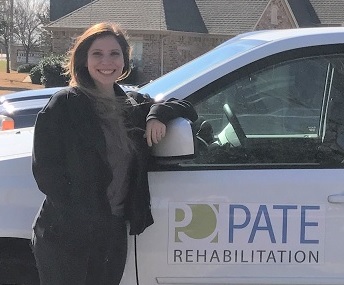Need Driver Training After Stroke and Brain Injury To Get Driving Again?
We're one of few centers to offer a driver rehabilitation training and evaluation program. It's free for patients who qualify and is real road training, not simulators.
Driving is one of those skills that our patients most want to regain for independence. Freedom to travel on your own is an essential skill that enhances quality of life. In some ways, it's the final step toward feeling you're back to your old self after brain injury.
Pate’s driver rehabilitation training program employs Driver Rehabilitation Specialists certified by the Association for Driver Rehabilitation Services (ADED). The program is included at no-cost for all our patients who medically qualify and is also available to others outside Pate for a reasonable fee.
The driver rehab program is one of few that does not utilize a simulator. On-the-road training is believed to better prepare participants for real road conditions.
“One of the top five goals for some of our high-level patients is to return to driving,” said Certified Driving Rehabilitation Specialist Christine Nelson, Registered Occupational Therapist at Pate. “Since we know our patients and have them for longer periods of time, we are better equipped to determine readiness or fitness to drive than most other driving programs.”
Eligibility Requirements
• Must already have a driver’s license
• Must have a physician’s order stating the patient is medically, physically, and cognitively able to drive
• Must require only low-tech adaptive equipment in order to drive (hand controls, spinner knobs, or other equipment that can be mechanically added)
(*Pate’s Driving Program is not designed for patients who need high-tech adaptive equipment, such as voice activated systems or head controlled units.)

Key Skills for Driving
Some people feel they're "just fine" to drive after their brain injury or stroke. They may not be aware of certain weaknesses that can make driving unsafe without retraining. That’s why a neuropsychological evaluation is very helpful. This evaluation carefully measures many areas of thinking abilities.
The neuropsychologist will analyze the person’s performance and give them detailed feedback about how well their brain is functioning. The individual must meet the minimum qualifications in these key competencies:
• Vision
• Visual perception
• Hearing
• Physical function
• Reaction time
• Cognitive function (attention, judgment, executive functioning, mental processing speed, sequencing, memory, and knowledge of road rules)
Some people are cleared to drive right away. Others may need more training. Common issues that may affect return to driving include difficulties with:
- Visual attention and scanning with the eyes
- Directing attention to one side or the other
- Tracking and attending to static and moving stimuli using their eyes, arms, legs, and hands
- Information processing speed
- Visual-motor reaction speed
- Motor abilities and planning
- Memory
- Problem-solving skills
Driver Rehabilitation Treatment
The Pate driver rehabilitation program plan includes an initial driving evaluation on the road with a driver rehabilitation specialist to assess the individual's current skills, and address any deficits that may require adaptive equipment.
This is a practical step in the process of returning to driving, which protects the individual, their passengers, and others around them. The evaluation is beneficial to both the individual and the entire community as it can help determine any compensatory strategies needed for safe driving.
Our specialists then provide real, on the road training in one of Pate's specially outfitted driver rehabilitation cars. Simulators simply can't compete with driving under real world conditions.
On the road training includes:
- Practice driving at various speeds
- Driving in different environments
- Driving under different light conditions
- Parking skills
- Driving in heavy pedestrian areas
Over time, most people are able to regain their skills and can resume driving safely and confidently.
After completion of the Pate Driving Program, final clearance from the Department of Public Safety (DPS), is required. This may require an appearance before the Medical Advisory Board.
Many patients graduate with no restrictions and can use their license again. Some patients may be granted a provisional license, which could limit the individual’s driving privileges to roads with a speed limit of 45 miles per hour or less.
Some provisional licenses also specify that the driver can only drive to work and home. Final decisions are made by the Department of Public Safety.
